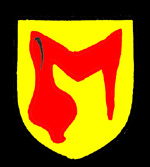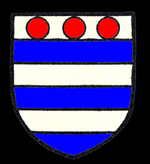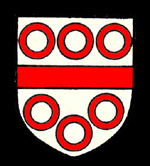Harrold Manor

The Hastings family coat of arms
Volume III of The Victoria County History for Bedfordshire, published in 1912, gives details of the four manors in Harrold. The Domesday Book of 1086 recorded that Harrold was a single manor, held by Countess Judith, William the Conqueror's niece, with Gilbert de Blosseville as her tenant. The overlordship of Harrold Manor was vested in the Honour of Huntingdon by the 13th century and later passed to the Hastings family, Earls of Pembroke. The Prior of the Knights Hospitaller of Saint John of Jerusalem claimed overlordship in 1346 and in both 1428 and 1509 the manor was recorded as held from the knights. The latter date is the last at which the overlordship was mentioned.
The de Blosseville family remained in Harrold until at least 1232 when Simon de Blosseville acknowledged the right of Ralph Morin to four hides of land in the parish. The Morin family had been in Harrold since at least 1194 when Ralph paid the sheriff sixty two shillings and a penny for half a knight's fee. Between 1202 and 1235 Ralph Morin was busy building up his land holdings and held two knights' fees in 1235 as tenant of the manor under the overlord. A knight's fee, fraction or multiple thereof, was the price paid to the Crown for owning land - the idea being that the value of the land you owned meant you had to furnish part, all, or a number of fully armed knights to the royal army on demand.
The manor contained two water mills by 1278, valued at forty one shillings in 1324. Harrold Park, attached to the manor, is first mentioned in 1278 when it contained 240 acres. This had been halved by 1325 and was last mentioned in 1805.

The de Grey family coat of arms
In 1272 Ralph Morin (grandson of the Ralph of 1235) and his son John were accused of unjustly distraining (taking goods against a debt) Hugh Gobion and Maud, his wife, who were free tenants in Harrold. At some point before 1278 the Morins alienated Harrold Manor to John de Grey. This family had their seat at Wrest Park in Silsoe and were later Earls of Kent. In 1706 Henry Grey, Earl of Kent, was also created Earl of Harrold. Marquess Grey and Duke of Kent.

The Lucas coat of arms
He died without surviving male heirs in 1740, the Earldom of Harrold and Dukedom of Kent becoming extinct at that point. His granddaughter Jemima inherited the title of Marquess Grey and Baron Lucas of Dingwall. She married Philip Yorke, later Earl of Hardwicke and they had two daughters, the eldest, Amabel, marrying Philip Yorke, later created Earl of Hardwicke. She was created Countess Grey of Wrest in her own right in 1816 and on her death without children in 1833 Harrold Manor passed to her nephew Thomas Philip Weddel. He died in 1859 and was succeeded by his daughter Anne, Lady Lucas, who married Earl Cowper and was succeeded by her son Francis Thomas de Grey in 1880. On his death without issue in 1905 the manor passed to his nephew who became both Lord of the Manor and Lord Lucas and Dingwall. A succession of Law of Property Acts in the 1920s abolished manorial fines and incidents as well as copyhold land tenure, thus abolishing manors in practically all but name.